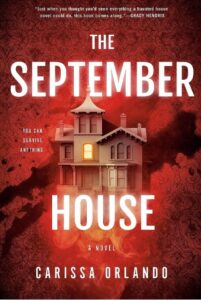Stars: 3 out of 5.
This was excellent until about 3/4 through the book. I honestly thought this would be a solid 5 start book, but then the ending ruined everything, at least for me. But let’s talk about the good parts first.
This was a very unusual haunted house story, because unlike many other stories I read, the inhabitants or said haunted house (well, at least Margaret) aren’t trying to get rid of the ghosts. They learn how to cohabit with them instead. I don’t think I’ve seen that done before, but then I haven’t read a lot of haunted house stories.
And to be honest, I wouldn’t be able to live like that, because despite the matter of fact way Margaret talks about the hauntings, things in this house are pretty horrible. Sure, it’s bearable 11 months out of the year, but the things that happen every September are a little bit too much to coexist with. I mean, walls that leak blood for a whole month? Constant screaming that won’t let you sleep? A ghost that bites if you come to close to him? Visions of horribly mutilated children haunting you all month? Thanks, but no thanks.
I think it’s more a testament to how horrible Margaret’s life has been even before the haunted house that she manages to settle into this and survive, even thrive most of the year in a house of horrors like that. And the more you learn about Margaret’s live with her “loving” husband, the more you understand why she prefers to live with ghosts. Heck, one of them basically does all the house chores and even cooks for her most of the year.
What I liked about this book was the ambiguity of the situation. Especially when Margaret’s daughter arrived and couldn’t see or hear any of the hauntings. I loved that even Margaret started doubting herself. Are the ghosts in this house real or are they simply a figment of her imagination? Especially since there is a history of mental illness in her family. And honestly, who would have blamed her for loosing her mind after everything she’d had to endure from Hal? I was perfectly okay if the story chose to take that direction, because that would have made Margaret even more endearing to me.
Unfortunately, the author chose to take a different route and ramp up the fear factor in the last third part of the book to rather ridiculous levels. I mean, those deaths at the end were absolutely useless. They didn’t drive the story forward, they didn’t serve any purpose except for shock value. And even then, not much shock value, because the readers didn’t particularly care about those policemen. We literally met them in the previous chapter.
It also made the ghosts seem extremely overpowered, which… well, I can only suspend my disbelief so much. It also raised a lot of questions as to how that haunting works. How is a ghost able to cook actual meals? How is it able to learn how a cellphone works? Or why the other members of the Vale family aren’t haunting this house, when all the other victims of Master Vale seem to be stuck there? Also, why didn’t Hal appear as a ghost?
Honestly, you shouldn’t think about this book too much after you are done reading, because the more you question this, the more holes you see in the reasoning and the narrative, and the more disappointing the book gets. I would suggest that you just enjoy it for what it is and don’t question it too much. After all, it’s a very good book almost all the way through. Too bad the ending was so disappointing.
PS: I received an advanced copy of this book via NetGalley in exchange for an honest review.

